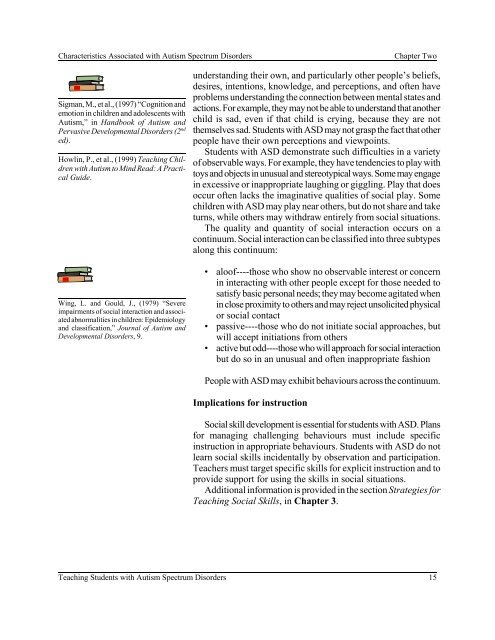Teaching Students with Autism Spectrum Disorders
Teaching Students with Autism Spectrum Disorders
Teaching Students with Autism Spectrum Disorders
Create successful ePaper yourself
Turn your PDF publications into a flip-book with our unique Google optimized e-Paper software.
Characteristics Associated <strong>with</strong> <strong>Autism</strong> <strong>Spectrum</strong> <strong>Disorders</strong> Chapter Two<br />
Sigman, M., et al., (1997) “Cognition and<br />
emotion in children and adolescents <strong>with</strong><br />
<strong>Autism</strong>,” in Handbook of <strong>Autism</strong> and<br />
Pervasive Developmental <strong>Disorders</strong> (2 nd<br />
ed).<br />
Howlin, P., et al., (1999) <strong>Teaching</strong> Children<br />
<strong>with</strong> <strong>Autism</strong> to Mind Read: A Practical<br />
Guide.<br />
Wing, L. and Gould, J., (1979) “Severe<br />
impairments of social interaction and associated<br />
abnormalities in children: Epidemiology<br />
and classification,” Journal of <strong>Autism</strong> and<br />
Developmental <strong>Disorders</strong>, 9.<br />
understanding their own, and particularly other people’s beliefs,<br />
desires, intentions, knowledge, and perceptions, and often have<br />
problems understanding the connection between mental states and<br />
actions. For example, they may not be able to understand that another<br />
child is sad, even if that child is crying, because they are not<br />
themselves sad. <strong>Students</strong> <strong>with</strong> ASD may not grasp the fact that other<br />
people have their own perceptions and viewpoints.<br />
<strong>Students</strong> <strong>with</strong> ASD demonstrate such difficulties in a variety<br />
of observable ways. For example, they have tendencies to play <strong>with</strong><br />
toys and objects in unusual and stereotypical ways. Some may engage<br />
in excessive or inappropriate laughing or giggling. Play that does<br />
occur often lacks the imaginative qualities of social play. Some<br />
children <strong>with</strong> ASD may play near others, but do not share and take<br />
turns, while others may <strong>with</strong>draw entirely from social situations.<br />
The quality and quantity of social interaction occurs on a<br />
continuum. Social interaction can be classified into three subtypes<br />
along this continuum:<br />
• aloof----those who show no observable interest or concern<br />
in interacting <strong>with</strong> other people except for those needed to<br />
satisfy basic personal needs; they may become agitated when<br />
in close proximity to others and may reject unsolicited physical<br />
or social contact<br />
• passive----those who do not initiate social approaches, but<br />
will accept initiations from others<br />
• active but odd----those who will approach for social interaction<br />
but do so in an unusual and often inappropriate fashion<br />
People <strong>with</strong> ASD may exhibit behaviours across the continuum.<br />
Implications for instruction<br />
Social skill development is essential for students <strong>with</strong> ASD. Plans<br />
for managing challenging behaviours must include specific<br />
instruction in appropriate behaviours. <strong>Students</strong> <strong>with</strong> ASD do not<br />
learn social skills incidentally by observation and participation.<br />
Teachers must target specific skills for explicit instruction and to<br />
provide support for using the skills in social situations.<br />
Additional information is provided in the section Strategies for<br />
<strong>Teaching</strong> Social Skills, in Chapter 3.<br />
<strong>Teaching</strong> <strong>Students</strong> <strong>with</strong> <strong>Autism</strong> <strong>Spectrum</strong> <strong>Disorders</strong> 15

















